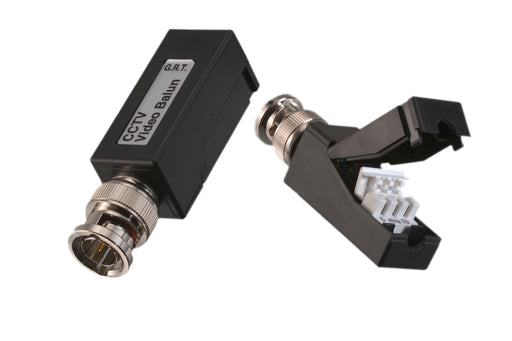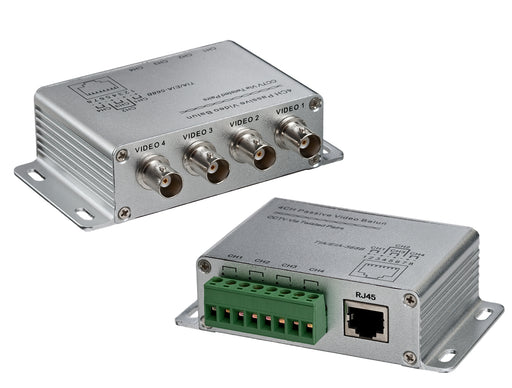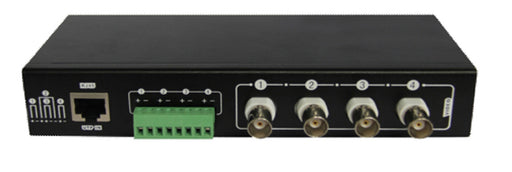Know More About Triplett CCTV Video Baluns and Ground Loop Isolator
What is CCTV video baluns?
CCTV video baluns, also known as video transceivers, are devices used in closed-circuit television (CCTV) systems to transmit video signals over long distances using twisted pair or other types of cables. The term "balun" originates from the combination of "balanced" and "unbalanced," describing the process of converting signals between these two formats. A video balun connector serves as a signal converter.
In the past, analog CCTV systems commonly relied on coaxial cables to transmit video signals from cameras to recorders or monitors. However, with the introduction of network-based IP cameras and the need for longer cable runs, video baluns emerged as a cost-effective and efficient alternative.
Video baluns typically come in pairs, consisting of a transmitter and a receiver. The transmitter is connected to the camera or video source, while the receiver is connected to the recorder or monitor. The main purpose of a balun is to transform the video signal from the camera into a compatible format for transmission over various types of cables, such as twisted pair, and then revert it back to the appropriate format at the receiving end. CCTV baluns come in two types: passive baluns and video baluns with power.
BNC Video Balun Connector purpose and working principal:
A video balun can be used along with a coaxial or UTP cable, and simply needs to be plugged into a connector. The purpose is to carry the video signal from a camera to DVR. It primarily converts an unbalanced video signal to a balanced one, and transmits them over a cable. The purpose of a balun is to reduce noise and ensure there is no current flowing along with the signal, through the transmission cable. A CCTV balun adapts the connectivity pattern to enable a UTP or coaxial cable to transmit video signal from the connected camera.
What is video balun with power ?
A video balun with power, also known as a video balun with power over Ethernet (PoE), is a specialized device used in video surveillance and security systems. It combines the functionality of a traditional video balun with the capability to transmit both video signals and electrical power over a single cable, typically an Ethernet cable (Cat5e or Cat6).
When to Utilize CCTV Baluns for Optimal Surveillance
Closed-Circuit Television (CCTV) systems are integral to modern security and surveillance. However, ensuring the efficient transmission of video signals, especially over extended distances or via diverse cable types, can be challenging. Enter CCTV baluns, essential components in certain surveillance setups. In this below pointers, we'll explore when to use CCTV baluns effectively to enhance your surveillance system.
- Overcoming Cable Length Limitations: Coaxial cables, commonly used in CCTV installations, have inherent limitations when it comes to cable length. Beyond a certain distance, signal degradation occurs, leading to poor video quality or even signal loss. CCTV baluns are the solution to this problem.
- Balancing Unbalanced Signals: CCTV cameras typically produce unbalanced video signals, whereas many transmission mediums, especially over long distances, require balanced signals for optimal performance. This is where CCTV baluns come into play. They act as signal converters, balancing the unbalanced signals from your cameras.
- Signal Clarity and Reliability: When extending cable distances, signal quality becomes critical. CCTV baluns ensure that your video signals remain clear and reliable throughout the extended journey. This is especially vital in surveillance scenarios where image clarity can make all the difference.
- Cost-Effective Solutions: Rather than investing in costly specialized cables for extended distances, CCTV baluns provide a cost-effective alternative. They allow you to leverage existing cable infrastructure or use standard Ethernet cables (UTP) for video transmission.
- Versatile Applications: CCTV baluns are versatile and can be used in various surveillance setups, including both analog and IP camera systems. They are compatible with a wide range of cameras and recording equipment, making them a flexible choice for diverse scenarios.
- Easy Installation: Installing CCTV baluns is relatively straightforward. They can be easily integrated into your existing surveillance system, reducing the complexity of cable management.
- Scalability and Future-Proofing: As your surveillance needs evolve, CCTV baluns offer scalability. You can extend cable distances as required without the need for a complete infrastructure overhaul, ensuring that your system remains adaptable and future-proof.
How many channels are there in video baluns?
The video baluns are distinguished on the basis of channels. The below are three popular types of baluns differentiated on the basis of channels.
- 4 Channel Video Baluns: As the name suggests, these video baluns can function as a transmitter or receiver for 4 security camera video signals over a single Cat5/Cat6 cable. These baluns are ideal for premises hosting small security systems with a few cameras.
- 8 Channel Video Baluns: These video baluns can function as transmitter or receiver for 8 security camera video signals. They are suited for medium-sized security systems.
- 16 Channel Video Baluns: These video baluns can transmit signals from 16 security cameras. They are found in larger security systems with many cameras.
What is the difference between AHD and HD Video Baluns?
Supported Video Formats:
- AHD Video Baluns: This balun supports Analog High Definition (AHD) video format, a high-resolution analog CCTV format. AHD cameras transmit up to 1080p resolution, which equals to 2 megapixels.
- HD Video Baluns: These baluns can transmit various high-definition analog video signals like AHD, High-Definition Television (HDTV), High-Definition Composite Video Interface (HD-CVI), and High-Definition Transport Video Interface (HD-TVI).
Transmission Distance:
- AHD Video Baluns: These video baluns can support longer transmission distances, up to 500 meters (1640 feet) for 1080p signals without significant signal degradation. This transmission distance will be affected by the type of cabling used.
- HD Video Baluns: The transmission distance of these baluns would differ depending on specific HD format. For instance, HD-TVI generally supports long distances, while most others are effective for short distances.
Compatibility:
- AHD Video Baluns: These baluns are compatible with DVRs and AHD cameras using the AHD format.
- HD Video Baluns: As said before, these baluns are compatible with different HD formats (HD-TVI, HD-CVI, and AHD) depending on the specific balun model. This contributes to its versatility, improving its flexibility in various installations.
Comparison of Active and Passive Baluns
Active and passive baluns are both devices used in video surveillance systems to transmit video signals over twisted-pair cables (typically UTP cables) instead of traditional coaxial cables. However, they differ in terms of their functionality and features. Here's a breakdown of the key differences between active and passive baluns:
| Aspect | Active Balun | Passive Balun |
|---|---|---|
| Functionality | Active baluns are powered devices that not only convert the video signal from coaxial to UTP format but also amplify and adjust the signal to compensate for losses over long cable runs. They require a power source, often provided through Power over Ethernet (PoE) or an external power supply. | Passive baluns, on the other hand, do not require external power sources. They convert the video signal from coaxial to UTP format but do not amplify or adjust the signal. Passive baluns are typically used for shorter cable runs where signal loss is minimal. |
| Signal Transmission Distance | Active baluns are capable of extending the transmission distance of video signals over UTP cables. They are suitable for longer cable runs, often reaching distances of hundreds of meters to over a kilometer, depending on the model and technology used. | Passive baluns are designed for shorter cable runs. They are effective for distances of up to a few hundred feet (approximately 60 to 200 meters) without significant signal degradation. |
| Signal Quality | Active baluns can provide better signal quality over longer distances because they amplify and equalize the signal. This results in clearer and more reliable video footage, particularly for high-resolution and high-definition cameras. | Passive baluns may experience some signal degradation over longer distances, leading to a potential loss of video quality. They are best suited for shorter cable runs with minimal signal attenuation. |
| Power Requirements | Active baluns require a power source to operate, which can be supplied through PoE or an external power adapter. This adds to the complexity of the installation but allows for signal amplification and longer cable runs. | Passive baluns do not require external power sources, simplifying installation. However, they lack signal amplification capabilities and are better suited for shorter distances. |
| Cost | Active baluns are generally more expensive than passive baluns due to their signal amplification and processing capabilities. The added cost may be justified for applications requiring longer cable runs and higher signal quality. | Passive baluns are cost-effective solutions for shorter cable runs where signal loss is minimal and signal quality requirements are lower. |
What is a CCTV ground loop isolator?
A CCTV ground loop isolator, also known as a video ground loop isolator, is a device used to eliminate or reduce ground loop interference or noise in CCTV video systems. It reduces loss of signals, especially in unbalanced power lines. Ground loop interference occurs when there is a difference in electrical potential between two or more ground points in a system, resulting in video signal distortions such as rolling bars, humming lines, or distorted images.
Why do you need a ground loop isolator?
You need a ground loop isolator to reduce the buzz sound that is created due to the voltage addition onto the transmission signal in a network. It supports most video formats such as HD-TVI and HD-CVI among others. Also, it offers a good resolution, clarity, and picture quality. You need to install them on the camera end of the connected cable.
How to install a ground loop isolator?
Depending on where you are installing the ground loop isolator, such as a car infotainment system, you need to switch off the system. Unplug the cables and select the right color coded connectors. The isolator has jacks into which these connectors need to be plugged. Check if the loop isolator has additional wires for grounding, else it may be self-grounded. Now, switch on the system and check the functioning.
How does a CCTV ground loop isolator work?
Here's how it typically works:
- Signal Input: The video signal from the CCTV camera or other video source is connected to the input of the ground loop isolator.
- Transforming the Signal: Inside the ground loop isolator, there are components such as transformers or other isolation circuitry. These components help convert the unbalanced video signal into a balanced signal.
- Isolating the Ground Loop: The ground loop isolator separates the ground connection of the input side from the output side. This isolation breaks the path of the ground loop, preventing unwanted currents from flowing through the video signal path.
- Signal Output: The isolated and balanced video signal is then outputted from the ground loop isolator and connected to the CCTV monitor, recorder, or other video destination.
How to Use a CCTV Balun?
To use a CCTV balun, you can simply connect the balanced line to one side of the balun and the unbalanced line to the other side. The balun will then convert the signal making if available for use by the unbalanced line.
Do Video Baluns Come in Various Types Tailored to Different Video Formats?
Yes,Video Baluns are designed for different video formats, such as analog (CVBS), high-definition (HD), and digital IP cameras. Considering your application requirement, choosing the appropriate balun matching your CCTV cameras' video format is important.
Is it Possible to Utilize Video Baluns with Both Analog and Digital CCTV Systems?
Yes, it is possible. Video baluns are known for their versatility and can be used with both analog and digital CCTV systems. They are designed to support various video formats and are compatible with standard video signals.
How Do You Troubleshoot Video Quality Issues While Using Video Baluns?
Troubleshooting video quality issues must involve a systematic approach to resolving potential problems, and video baluns can be effectively used for this task. Begin with visual inspection of cable connections and ensure proper cable termination at both ends. Ensure the video baluns are compatible with the CCTV systems you’re using. Also, checking the UTP cables for damage and testing other equipment can help identify and resolve issues.
Can I Use Passive and Active Video Baluns in the Same System?
It is advisable to use either active or passive baluns throughout. However, mixing them also works in many cases. It is crucial to follow the manufacturer’s guidelines and check for compatibility.
Is it Possible to Use Video Baluns and Ground Loop Isolators Together?
Yes, it is possible. They are used in CCTV systems to achieve optimal video signal quality. Video baluns transmit the signal over UTP cables, and ground loop isolators help eliminate interference caused by ground loops.
Browse More Security, CCTV & Cabling Equipment Collections
Camera Install & Maintenance:
| Security Camera Testers | HD LED Test Monitors | HDMI & IP Extenders |
| HDMI Cables | CAT6a Shielded Cable |
CCTV Connectors:
| BNC Adapters | BNC Connectors | F Connectors |
| Compression Connectors | RJ45 (CAT5-6)Connectors | Cabling Hand Tools & Kits |
| CCTV Coax Connectors | Modular Connector | Between Series |




